Business Environment Report: Analysis of Tesco and Oxfam Businesses
VerifiedAdded on 2023/04/03
|10
|2514
|458
Report
AI Summary
This report provides a comprehensive analysis of the business environments of Tesco and Oxfam. It begins by defining different types of businesses (service, merchandising, and manufacturing) and ownership structures (sole trader, partnership, charity). The report then explores the stakeholders influencing these businesses, including shareholders, customers, and suppliers. The organizational structures of Tesco (hierarchical) and Oxfam (flatter, geographical) are described, along with how these structures support their respective purposes. The influence of economic environments (recession, inflation, government policy) on business activities is examined. Finally, the report uses PESTEL analysis to assess the impact of political, legal, and social factors on the two organizations and their stakeholders. The report provides a detailed comparison of the two businesses and highlights the importance of understanding the business environment for effective management.
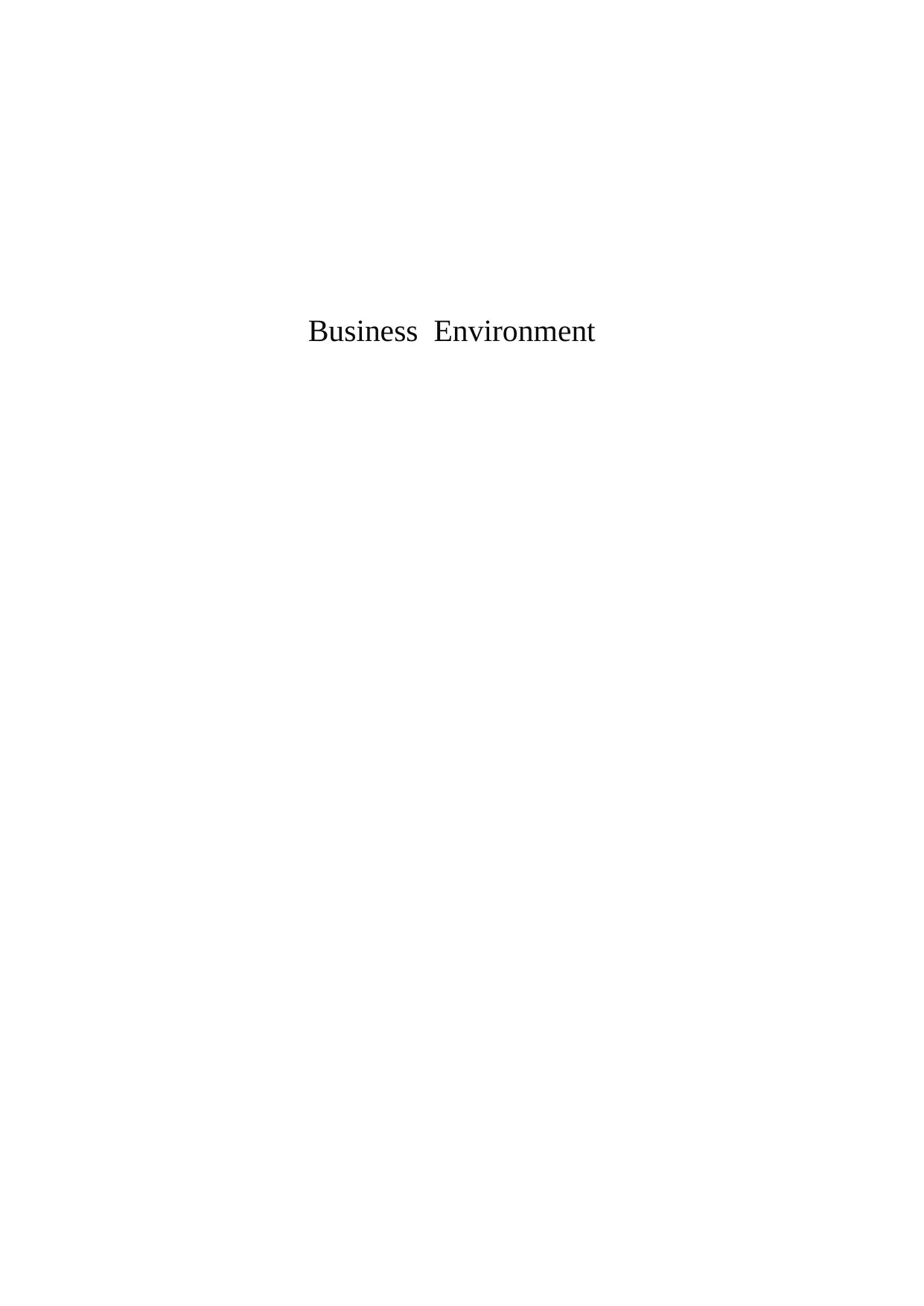
Business Environment
Paraphrase This Document
Need a fresh take? Get an instant paraphrase of this document with our AI Paraphraser
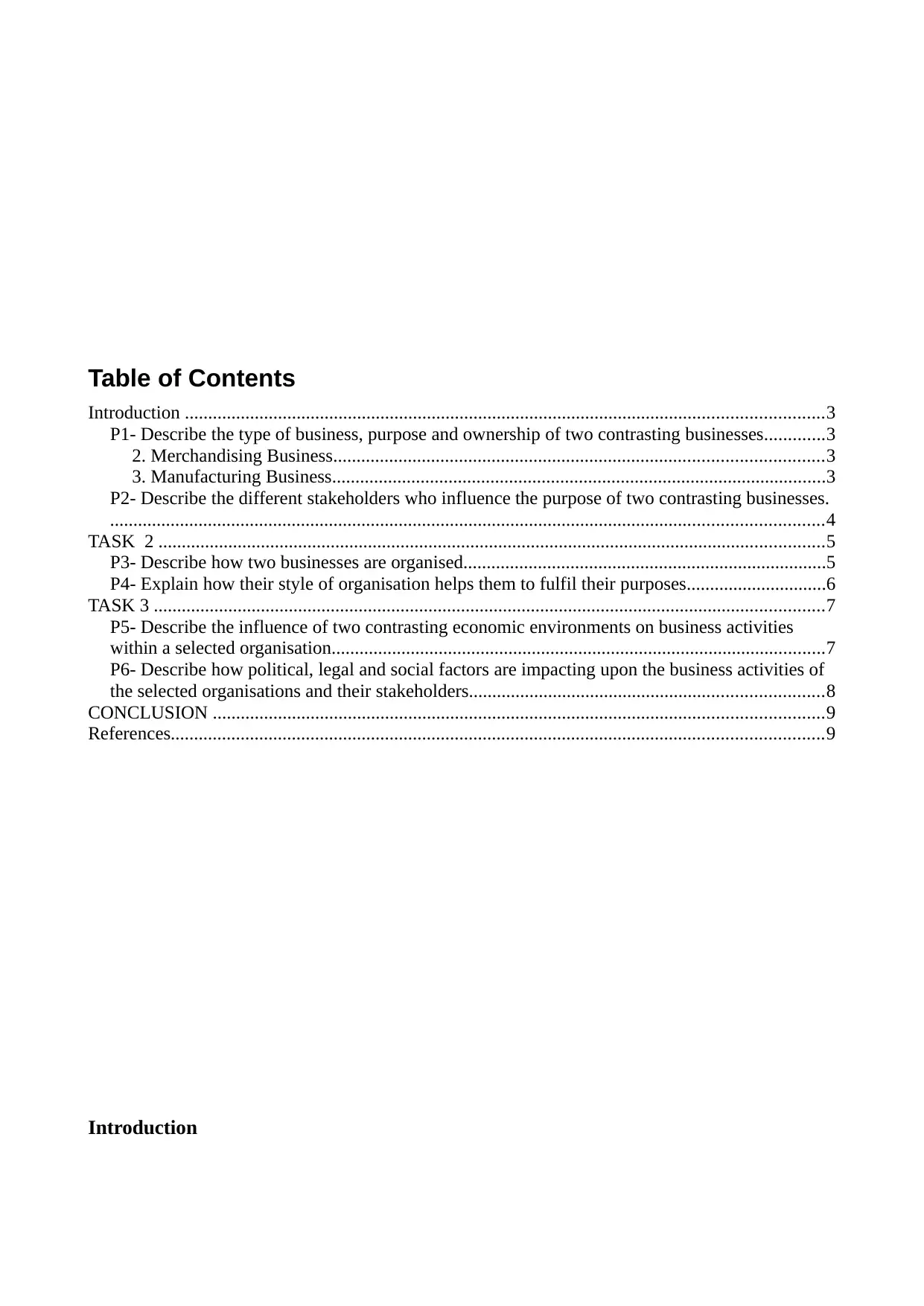
Table of Contents
Introduction .........................................................................................................................................3
P1- Describe the type of business, purpose and ownership of two contrasting businesses.............3
2. Merchandising Business.........................................................................................................3
3. Manufacturing Business..........................................................................................................3
P2- Describe the different stakeholders who influence the purpose of two contrasting businesses.
.........................................................................................................................................................4
TASK 2 ...............................................................................................................................................5
P3- Describe how two businesses are organised..............................................................................5
P4- Explain how their style of organisation helps them to fulfil their purposes..............................6
TASK 3 ................................................................................................................................................7
P5- Describe the influence of two contrasting economic environments on business activities
within a selected organisation..........................................................................................................7
P6- Describe how political, legal and social factors are impacting upon the business activities of
the selected organisations and their stakeholders............................................................................8
CONCLUSION ...................................................................................................................................9
References............................................................................................................................................9
Introduction
Introduction .........................................................................................................................................3
P1- Describe the type of business, purpose and ownership of two contrasting businesses.............3
2. Merchandising Business.........................................................................................................3
3. Manufacturing Business..........................................................................................................3
P2- Describe the different stakeholders who influence the purpose of two contrasting businesses.
.........................................................................................................................................................4
TASK 2 ...............................................................................................................................................5
P3- Describe how two businesses are organised..............................................................................5
P4- Explain how their style of organisation helps them to fulfil their purposes..............................6
TASK 3 ................................................................................................................................................7
P5- Describe the influence of two contrasting economic environments on business activities
within a selected organisation..........................................................................................................7
P6- Describe how political, legal and social factors are impacting upon the business activities of
the selected organisations and their stakeholders............................................................................8
CONCLUSION ...................................................................................................................................9
References............................................................................................................................................9
Introduction
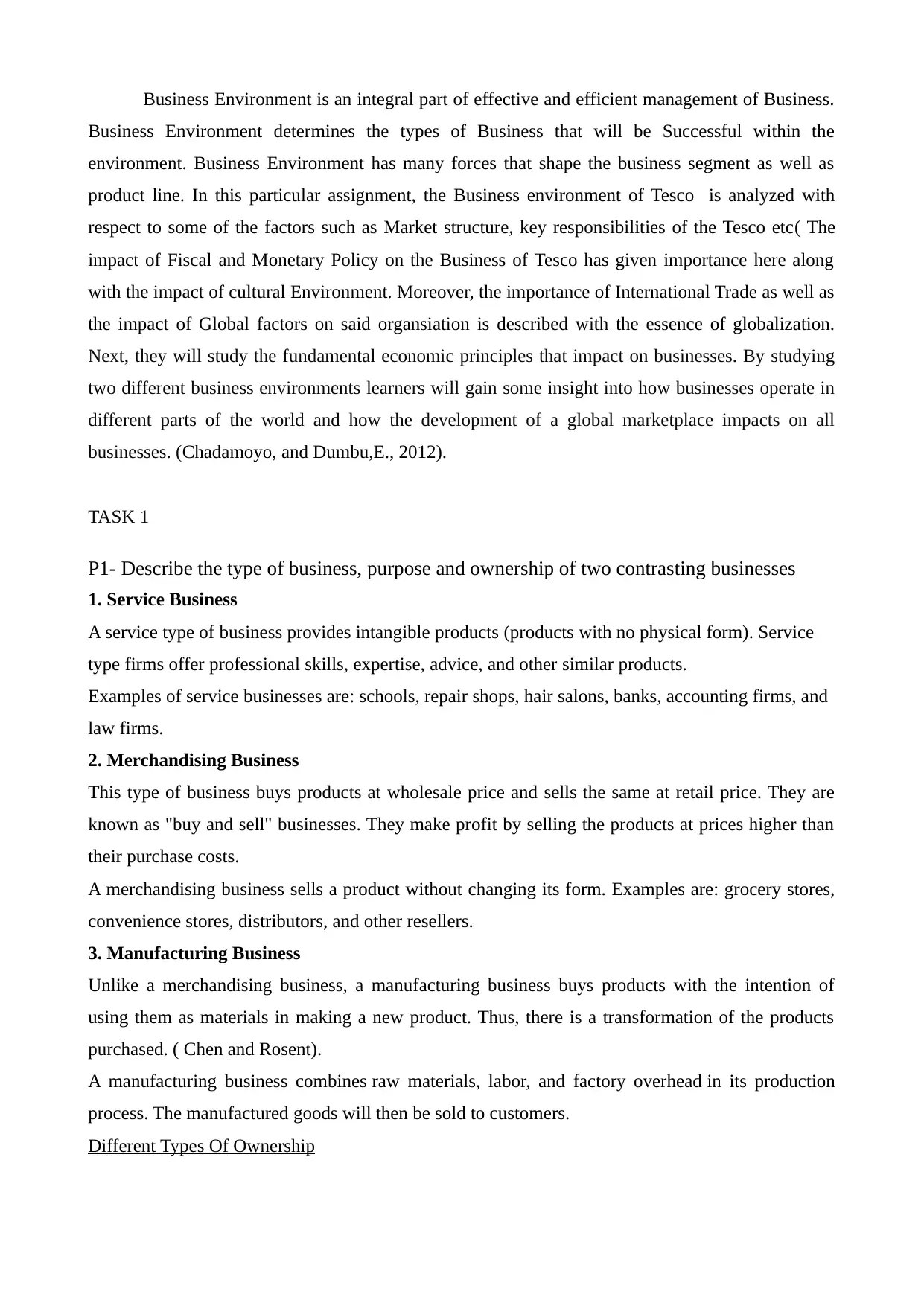
Business Environment is an integral part of effective and efficient management of Business.
Business Environment determines the types of Business that will be Successful within the
environment. Business Environment has many forces that shape the business segment as well as
product line. In this particular assignment, the Business environment of Tesco is analyzed with
respect to some of the factors such as Market structure, key responsibilities of the Tesco etc( The
impact of Fiscal and Monetary Policy on the Business of Tesco has given importance here along
with the impact of cultural Environment. Moreover, the importance of International Trade as well as
the impact of Global factors on said organsiation is described with the essence of globalization.
Next, they will study the fundamental economic principles that impact on businesses. By studying
two different business environments learners will gain some insight into how businesses operate in
different parts of the world and how the development of a global marketplace impacts on all
businesses. (Chadamoyo, and Dumbu,E., 2012).
TASK 1
P1- Describe the type of business, purpose and ownership of two contrasting businesses
1. Service Business
A service type of business provides intangible products (products with no physical form). Service
type firms offer professional skills, expertise, advice, and other similar products.
Examples of service businesses are: schools, repair shops, hair salons, banks, accounting firms, and
law firms.
2. Merchandising Business
This type of business buys products at wholesale price and sells the same at retail price. They are
known as "buy and sell" businesses. They make profit by selling the products at prices higher than
their purchase costs.
A merchandising business sells a product without changing its form. Examples are: grocery stores,
convenience stores, distributors, and other resellers.
3. Manufacturing Business
Unlike a merchandising business, a manufacturing business buys products with the intention of
using them as materials in making a new product. Thus, there is a transformation of the products
purchased. ( Chen and Rosent).
A manufacturing business combines raw materials, labor, and factory overhead in its production
process. The manufactured goods will then be sold to customers.
Different Types Of Ownership
Business Environment determines the types of Business that will be Successful within the
environment. Business Environment has many forces that shape the business segment as well as
product line. In this particular assignment, the Business environment of Tesco is analyzed with
respect to some of the factors such as Market structure, key responsibilities of the Tesco etc( The
impact of Fiscal and Monetary Policy on the Business of Tesco has given importance here along
with the impact of cultural Environment. Moreover, the importance of International Trade as well as
the impact of Global factors on said organsiation is described with the essence of globalization.
Next, they will study the fundamental economic principles that impact on businesses. By studying
two different business environments learners will gain some insight into how businesses operate in
different parts of the world and how the development of a global marketplace impacts on all
businesses. (Chadamoyo, and Dumbu,E., 2012).
TASK 1
P1- Describe the type of business, purpose and ownership of two contrasting businesses
1. Service Business
A service type of business provides intangible products (products with no physical form). Service
type firms offer professional skills, expertise, advice, and other similar products.
Examples of service businesses are: schools, repair shops, hair salons, banks, accounting firms, and
law firms.
2. Merchandising Business
This type of business buys products at wholesale price and sells the same at retail price. They are
known as "buy and sell" businesses. They make profit by selling the products at prices higher than
their purchase costs.
A merchandising business sells a product without changing its form. Examples are: grocery stores,
convenience stores, distributors, and other resellers.
3. Manufacturing Business
Unlike a merchandising business, a manufacturing business buys products with the intention of
using them as materials in making a new product. Thus, there is a transformation of the products
purchased. ( Chen and Rosent).
A manufacturing business combines raw materials, labor, and factory overhead in its production
process. The manufactured goods will then be sold to customers.
Different Types Of Ownership
⊘ This is a preview!⊘
Do you want full access?
Subscribe today to unlock all pages.

Trusted by 1+ million students worldwide
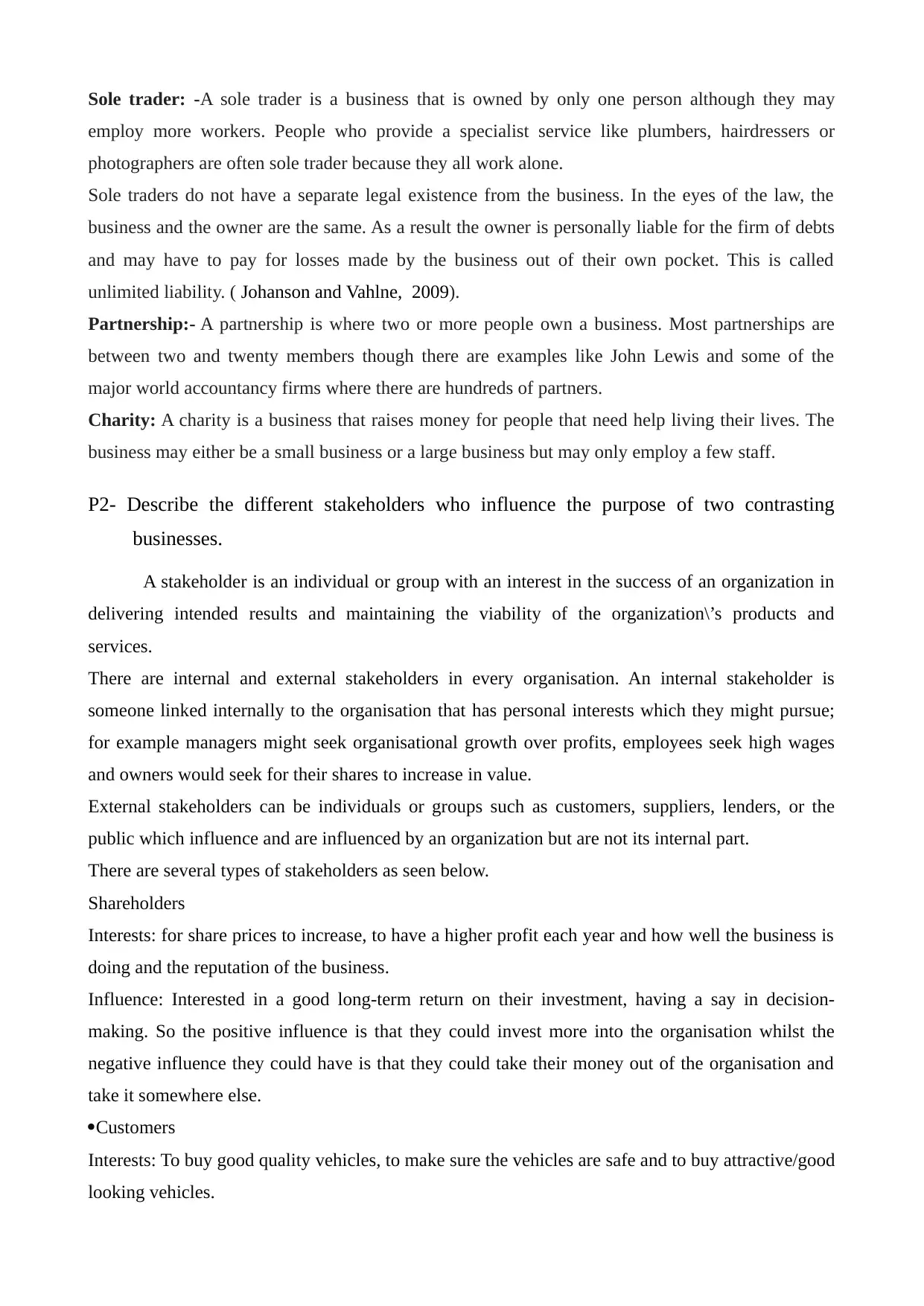
Sole trader: -A sole trader is a business that is owned by only one person although they may
employ more workers. People who provide a specialist service like plumbers, hairdressers or
photographers are often sole trader because they all work alone.
Sole traders do not have a separate legal existence from the business. In the eyes of the law, the
business and the owner are the same. As a result the owner is personally liable for the firm of debts
and may have to pay for losses made by the business out of their own pocket. This is called
unlimited liability. ( Johanson and Vahlne, 2009).
Partnership:- A partnership is where two or more people own a business. Most partnerships are
between two and twenty members though there are examples like John Lewis and some of the
major world accountancy firms where there are hundreds of partners.
Charity: A charity is a business that raises money for people that need help living their lives. The
business may either be a small business or a large business but may only employ a few staff.
P2- Describe the different stakeholders who influence the purpose of two contrasting
businesses.
A stakeholder is an individual or group with an interest in the success of an organization in
delivering intended results and maintaining the viability of the organization\’s products and
services.
There are internal and external stakeholders in every organisation. An internal stakeholder is
someone linked internally to the organisation that has personal interests which they might pursue;
for example managers might seek organisational growth over profits, employees seek high wages
and owners would seek for their shares to increase in value.
External stakeholders can be individuals or groups such as customers, suppliers, lenders, or the
public which influence and are influenced by an organization but are not its internal part.
There are several types of stakeholders as seen below.
Shareholders
Interests: for share prices to increase, to have a higher profit each year and how well the business is
doing and the reputation of the business.
Influence: Interested in a good long-term return on their investment, having a say in decision-
making. So the positive influence is that they could invest more into the organisation whilst the
negative influence they could have is that they could take their money out of the organisation and
take it somewhere else.
Customers
Interests: To buy good quality vehicles, to make sure the vehicles are safe and to buy attractive/good
looking vehicles.
employ more workers. People who provide a specialist service like plumbers, hairdressers or
photographers are often sole trader because they all work alone.
Sole traders do not have a separate legal existence from the business. In the eyes of the law, the
business and the owner are the same. As a result the owner is personally liable for the firm of debts
and may have to pay for losses made by the business out of their own pocket. This is called
unlimited liability. ( Johanson and Vahlne, 2009).
Partnership:- A partnership is where two or more people own a business. Most partnerships are
between two and twenty members though there are examples like John Lewis and some of the
major world accountancy firms where there are hundreds of partners.
Charity: A charity is a business that raises money for people that need help living their lives. The
business may either be a small business or a large business but may only employ a few staff.
P2- Describe the different stakeholders who influence the purpose of two contrasting
businesses.
A stakeholder is an individual or group with an interest in the success of an organization in
delivering intended results and maintaining the viability of the organization\’s products and
services.
There are internal and external stakeholders in every organisation. An internal stakeholder is
someone linked internally to the organisation that has personal interests which they might pursue;
for example managers might seek organisational growth over profits, employees seek high wages
and owners would seek for their shares to increase in value.
External stakeholders can be individuals or groups such as customers, suppliers, lenders, or the
public which influence and are influenced by an organization but are not its internal part.
There are several types of stakeholders as seen below.
Shareholders
Interests: for share prices to increase, to have a higher profit each year and how well the business is
doing and the reputation of the business.
Influence: Interested in a good long-term return on their investment, having a say in decision-
making. So the positive influence is that they could invest more into the organisation whilst the
negative influence they could have is that they could take their money out of the organisation and
take it somewhere else.
Customers
Interests: To buy good quality vehicles, to make sure the vehicles are safe and to buy attractive/good
looking vehicles.
Paraphrase This Document
Need a fresh take? Get an instant paraphrase of this document with our AI Paraphraser
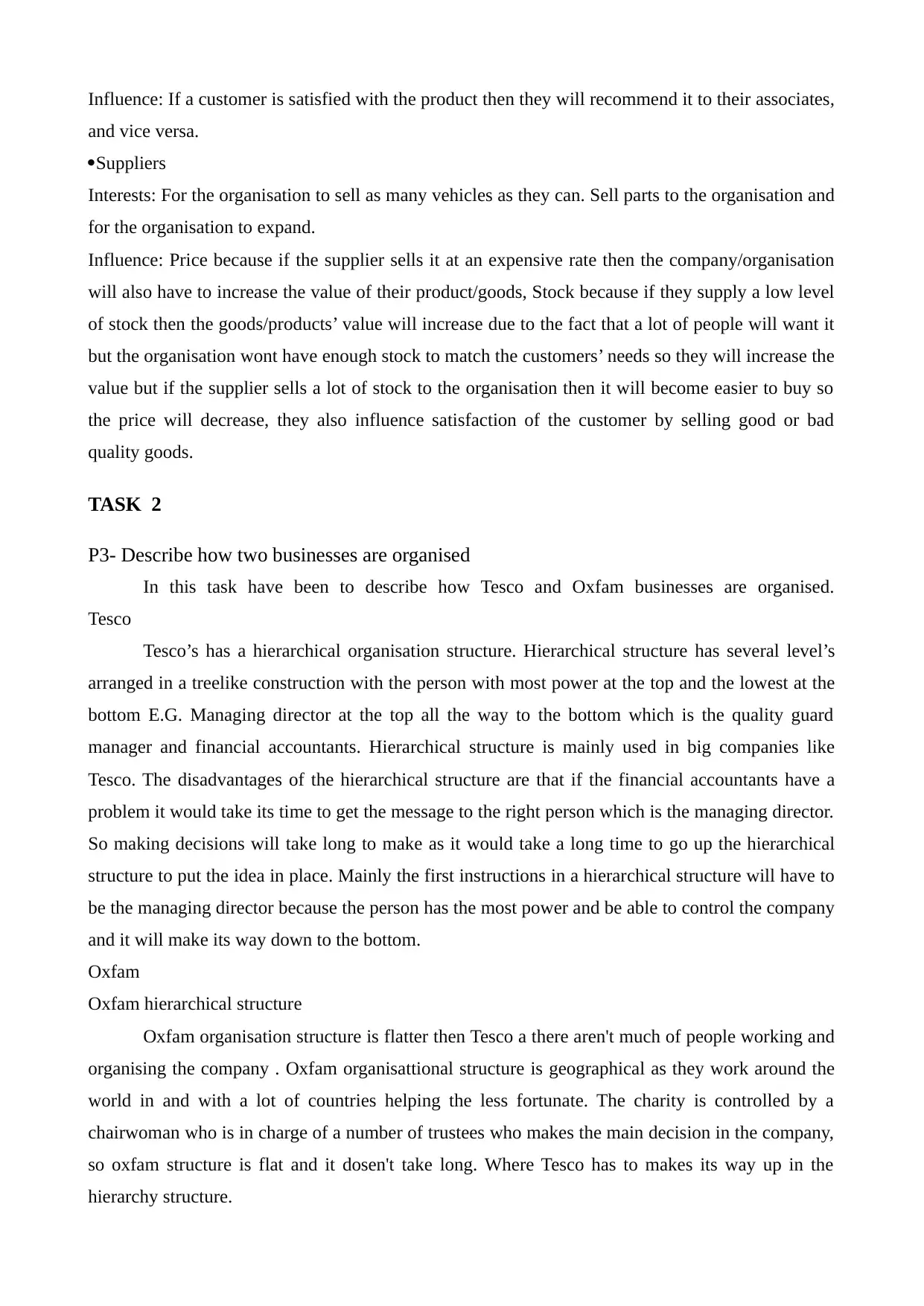
Influence: If a customer is satisfied with the product then they will recommend it to their associates,
and vice versa.
Suppliers
Interests: For the organisation to sell as many vehicles as they can. Sell parts to the organisation and
for the organisation to expand.
Influence: Price because if the supplier sells it at an expensive rate then the company/organisation
will also have to increase the value of their product/goods, Stock because if they supply a low level
of stock then the goods/products’ value will increase due to the fact that a lot of people will want it
but the organisation wont have enough stock to match the customers’ needs so they will increase the
value but if the supplier sells a lot of stock to the organisation then it will become easier to buy so
the price will decrease, they also influence satisfaction of the customer by selling good or bad
quality goods.
TASK 2
P3- Describe how two businesses are organised
In this task have been to describe how Tesco and Oxfam businesses are organised.
Tesco
Tesco’s has a hierarchical organisation structure. Hierarchical structure has several level’s
arranged in a treelike construction with the person with most power at the top and the lowest at the
bottom E.G. Managing director at the top all the way to the bottom which is the quality guard
manager and financial accountants. Hierarchical structure is mainly used in big companies like
Tesco. The disadvantages of the hierarchical structure are that if the financial accountants have a
problem it would take its time to get the message to the right person which is the managing director.
So making decisions will take long to make as it would take a long time to go up the hierarchical
structure to put the idea in place. Mainly the first instructions in a hierarchical structure will have to
be the managing director because the person has the most power and be able to control the company
and it will make its way down to the bottom.
Oxfam
Oxfam hierarchical structure
Oxfam organisation structure is flatter then Tesco a there aren't much of people working and
organising the company . Oxfam organisattional structure is geographical as they work around the
world in and with a lot of countries helping the less fortunate. The charity is controlled by a
chairwoman who is in charge of a number of trustees who makes the main decision in the company,
so oxfam structure is flat and it dosen't take long. Where Tesco has to makes its way up in the
hierarchy structure.
and vice versa.
Suppliers
Interests: For the organisation to sell as many vehicles as they can. Sell parts to the organisation and
for the organisation to expand.
Influence: Price because if the supplier sells it at an expensive rate then the company/organisation
will also have to increase the value of their product/goods, Stock because if they supply a low level
of stock then the goods/products’ value will increase due to the fact that a lot of people will want it
but the organisation wont have enough stock to match the customers’ needs so they will increase the
value but if the supplier sells a lot of stock to the organisation then it will become easier to buy so
the price will decrease, they also influence satisfaction of the customer by selling good or bad
quality goods.
TASK 2
P3- Describe how two businesses are organised
In this task have been to describe how Tesco and Oxfam businesses are organised.
Tesco
Tesco’s has a hierarchical organisation structure. Hierarchical structure has several level’s
arranged in a treelike construction with the person with most power at the top and the lowest at the
bottom E.G. Managing director at the top all the way to the bottom which is the quality guard
manager and financial accountants. Hierarchical structure is mainly used in big companies like
Tesco. The disadvantages of the hierarchical structure are that if the financial accountants have a
problem it would take its time to get the message to the right person which is the managing director.
So making decisions will take long to make as it would take a long time to go up the hierarchical
structure to put the idea in place. Mainly the first instructions in a hierarchical structure will have to
be the managing director because the person has the most power and be able to control the company
and it will make its way down to the bottom.
Oxfam
Oxfam hierarchical structure
Oxfam organisation structure is flatter then Tesco a there aren't much of people working and
organising the company . Oxfam organisattional structure is geographical as they work around the
world in and with a lot of countries helping the less fortunate. The charity is controlled by a
chairwoman who is in charge of a number of trustees who makes the main decision in the company,
so oxfam structure is flat and it dosen't take long. Where Tesco has to makes its way up in the
hierarchy structure.
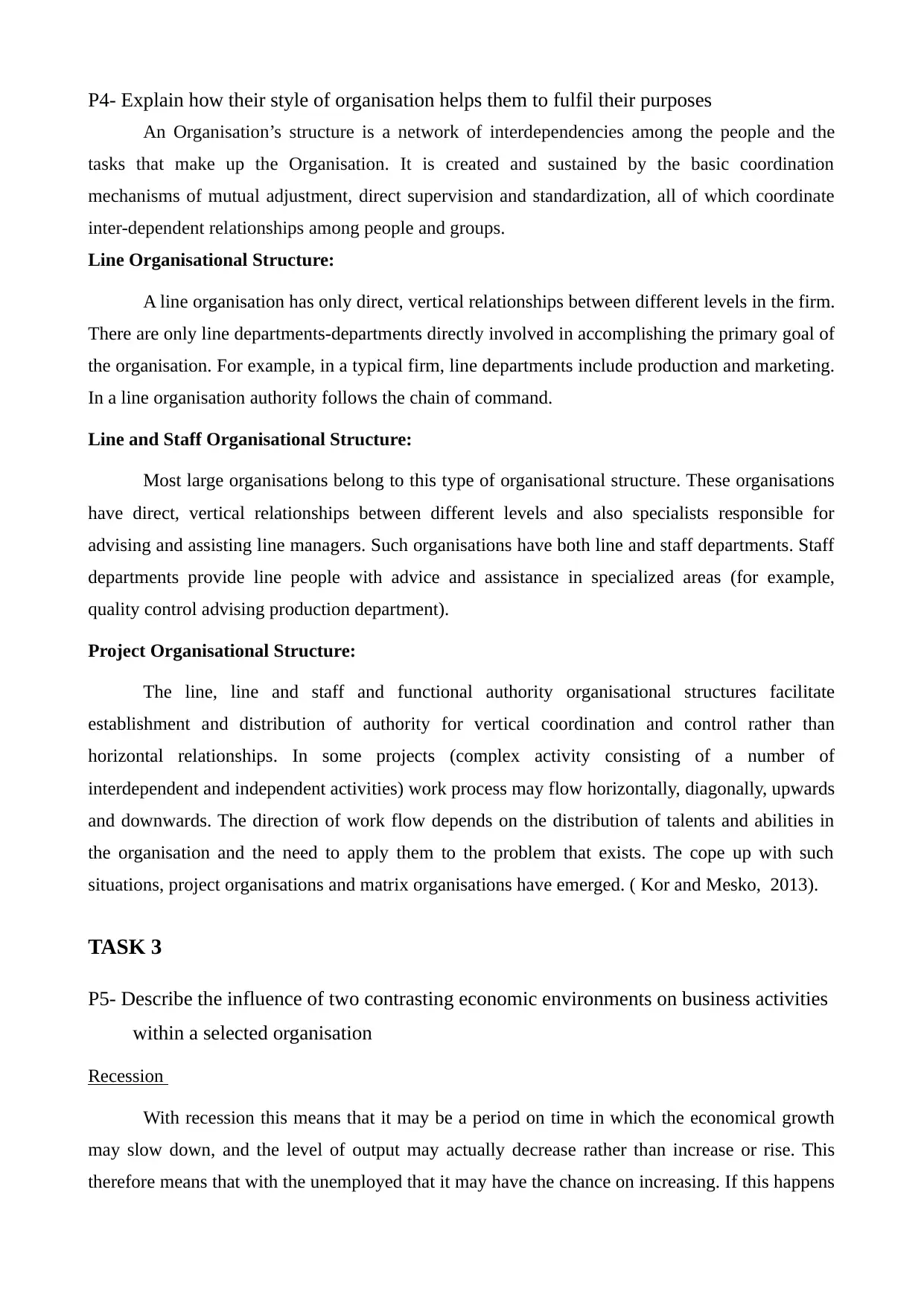
P4- Explain how their style of organisation helps them to fulfil their purposes
An Organisation’s structure is a network of interdependencies among the people and the
tasks that make up the Organisation. It is created and sustained by the basic coordination
mechanisms of mutual adjustment, direct supervision and standardization, all of which coordinate
inter-dependent relationships among people and groups.
Line Organisational Structure:
A line organisation has only direct, vertical relationships between different levels in the firm.
There are only line departments-departments directly involved in accomplishing the primary goal of
the organisation. For example, in a typical firm, line departments include production and marketing.
In a line organisation authority follows the chain of command.
Line and Staff Organisational Structure:
Most large organisations belong to this type of organisational structure. These organisations
have direct, vertical relationships between different levels and also specialists responsible for
advising and assisting line managers. Such organisations have both line and staff departments. Staff
departments provide line people with advice and assistance in specialized areas (for example,
quality control advising production department).
Project Organisational Structure:
The line, line and staff and functional authority organisational structures facilitate
establishment and distribution of authority for vertical coordination and control rather than
horizontal relationships. In some projects (complex activity consisting of a number of
interdependent and independent activities) work process may flow horizontally, diagonally, upwards
and downwards. The direction of work flow depends on the distribution of talents and abilities in
the organisation and the need to apply them to the problem that exists. The cope up with such
situations, project organisations and matrix organisations have emerged. ( Kor and Mesko, 2013).
TASK 3
P5- Describe the influence of two contrasting economic environments on business activities
within a selected organisation
Recession
With recession this means that it may be a period on time in which the economical growth
may slow down, and the level of output may actually decrease rather than increase or rise. This
therefore means that with the unemployed that it may have the chance on increasing. If this happens
An Organisation’s structure is a network of interdependencies among the people and the
tasks that make up the Organisation. It is created and sustained by the basic coordination
mechanisms of mutual adjustment, direct supervision and standardization, all of which coordinate
inter-dependent relationships among people and groups.
Line Organisational Structure:
A line organisation has only direct, vertical relationships between different levels in the firm.
There are only line departments-departments directly involved in accomplishing the primary goal of
the organisation. For example, in a typical firm, line departments include production and marketing.
In a line organisation authority follows the chain of command.
Line and Staff Organisational Structure:
Most large organisations belong to this type of organisational structure. These organisations
have direct, vertical relationships between different levels and also specialists responsible for
advising and assisting line managers. Such organisations have both line and staff departments. Staff
departments provide line people with advice and assistance in specialized areas (for example,
quality control advising production department).
Project Organisational Structure:
The line, line and staff and functional authority organisational structures facilitate
establishment and distribution of authority for vertical coordination and control rather than
horizontal relationships. In some projects (complex activity consisting of a number of
interdependent and independent activities) work process may flow horizontally, diagonally, upwards
and downwards. The direction of work flow depends on the distribution of talents and abilities in
the organisation and the need to apply them to the problem that exists. The cope up with such
situations, project organisations and matrix organisations have emerged. ( Kor and Mesko, 2013).
TASK 3
P5- Describe the influence of two contrasting economic environments on business activities
within a selected organisation
Recession
With recession this means that it may be a period on time in which the economical growth
may slow down, and the level of output may actually decrease rather than increase or rise. This
therefore means that with the unemployed that it may have the chance on increasing. If this happens
⊘ This is a preview!⊘
Do you want full access?
Subscribe today to unlock all pages.

Trusted by 1+ million students worldwide
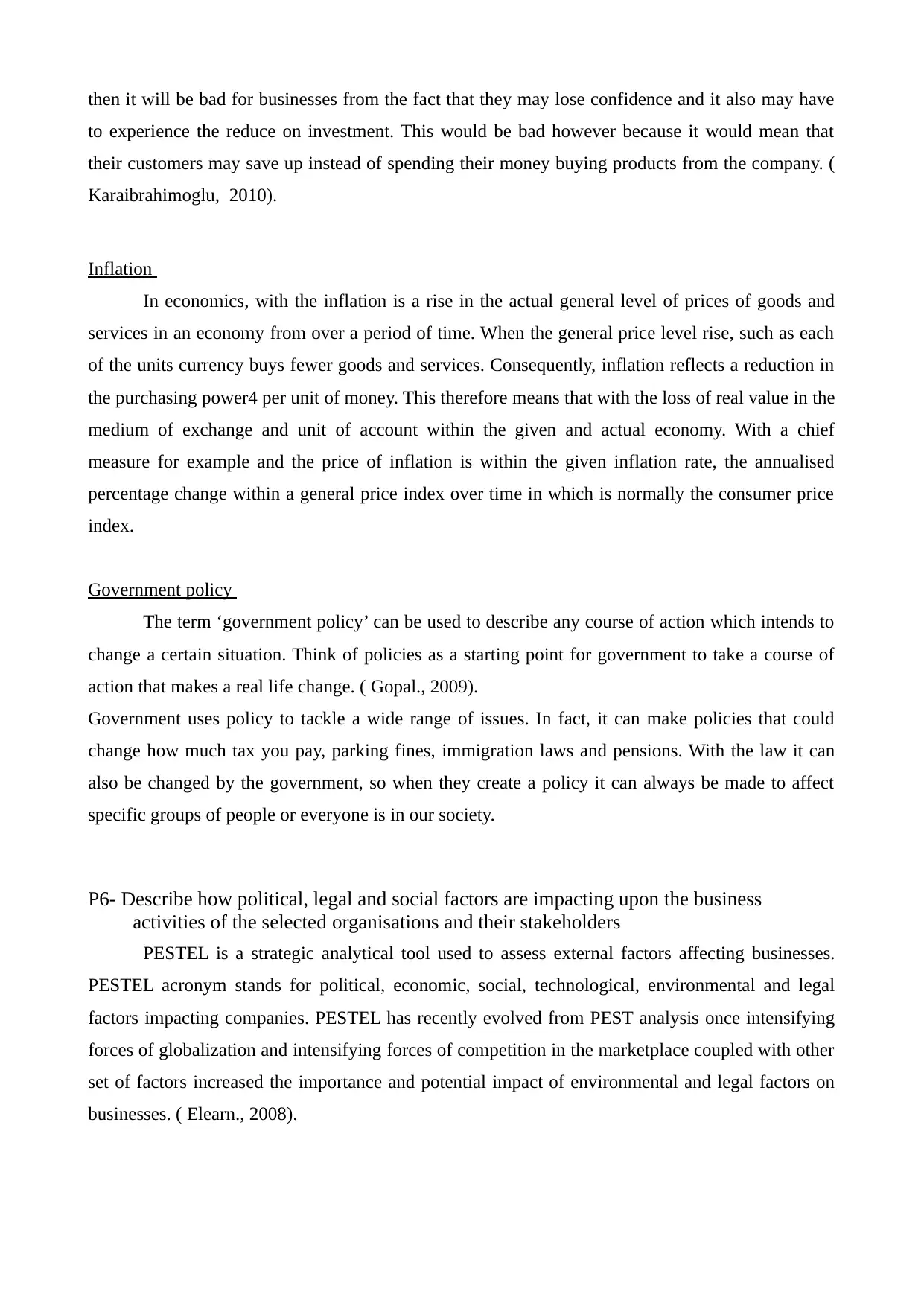
then it will be bad for businesses from the fact that they may lose confidence and it also may have
to experience the reduce on investment. This would be bad however because it would mean that
their customers may save up instead of spending their money buying products from the company. (
Karaibrahimoglu, 2010).
Inflation
In economics, with the inflation is a rise in the actual general level of prices of goods and
services in an economy from over a period of time. When the general price level rise, such as each
of the units currency buys fewer goods and services. Consequently, inflation reflects a reduction in
the purchasing power4 per unit of money. This therefore means that with the loss of real value in the
medium of exchange and unit of account within the given and actual economy. With a chief
measure for example and the price of inflation is within the given inflation rate, the annualised
percentage change within a general price index over time in which is normally the consumer price
index.
Government policy
The term ‘government policy’ can be used to describe any course of action which intends to
change a certain situation. Think of policies as a starting point for government to take a course of
action that makes a real life change. ( Gopal., 2009).
Government uses policy to tackle a wide range of issues. In fact, it can make policies that could
change how much tax you pay, parking fines, immigration laws and pensions. With the law it can
also be changed by the government, so when they create a policy it can always be made to affect
specific groups of people or everyone is in our society.
P6- Describe how political, legal and social factors are impacting upon the business
activities of the selected organisations and their stakeholders
PESTEL is a strategic analytical tool used to assess external factors affecting businesses.
PESTEL acronym stands for political, economic, social, technological, environmental and legal
factors impacting companies. PESTEL has recently evolved from PEST analysis once intensifying
forces of globalization and intensifying forces of competition in the marketplace coupled with other
set of factors increased the importance and potential impact of environmental and legal factors on
businesses. ( Elearn., 2008).
to experience the reduce on investment. This would be bad however because it would mean that
their customers may save up instead of spending their money buying products from the company. (
Karaibrahimoglu, 2010).
Inflation
In economics, with the inflation is a rise in the actual general level of prices of goods and
services in an economy from over a period of time. When the general price level rise, such as each
of the units currency buys fewer goods and services. Consequently, inflation reflects a reduction in
the purchasing power4 per unit of money. This therefore means that with the loss of real value in the
medium of exchange and unit of account within the given and actual economy. With a chief
measure for example and the price of inflation is within the given inflation rate, the annualised
percentage change within a general price index over time in which is normally the consumer price
index.
Government policy
The term ‘government policy’ can be used to describe any course of action which intends to
change a certain situation. Think of policies as a starting point for government to take a course of
action that makes a real life change. ( Gopal., 2009).
Government uses policy to tackle a wide range of issues. In fact, it can make policies that could
change how much tax you pay, parking fines, immigration laws and pensions. With the law it can
also be changed by the government, so when they create a policy it can always be made to affect
specific groups of people or everyone is in our society.
P6- Describe how political, legal and social factors are impacting upon the business
activities of the selected organisations and their stakeholders
PESTEL is a strategic analytical tool used to assess external factors affecting businesses.
PESTEL acronym stands for political, economic, social, technological, environmental and legal
factors impacting companies. PESTEL has recently evolved from PEST analysis once intensifying
forces of globalization and intensifying forces of competition in the marketplace coupled with other
set of factors increased the importance and potential impact of environmental and legal factors on
businesses. ( Elearn., 2008).
Paraphrase This Document
Need a fresh take? Get an instant paraphrase of this document with our AI Paraphraser
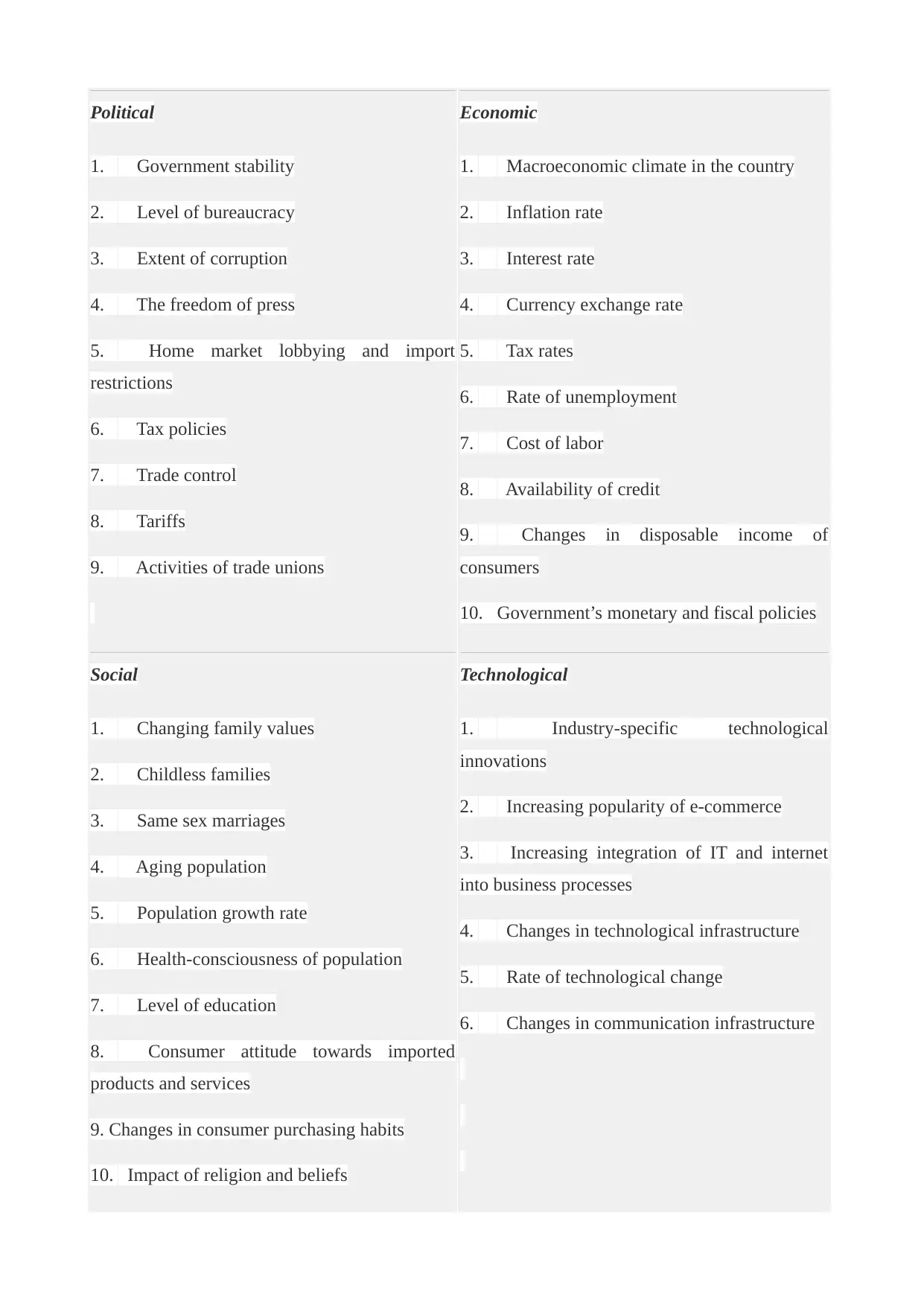
Political
1. Government stability
2. Level of bureaucracy
3. Extent of corruption
4. The freedom of press
5. Home market lobbying and import
restrictions
6. Tax policies
7. Trade control
8. Tariffs
9. Activities of trade unions
Economic
1. Macroeconomic climate in the country
2. Inflation rate
3. Interest rate
4. Currency exchange rate
5. Tax rates
6. Rate of unemployment
7. Cost of labor
8. Availability of credit
9. Changes in disposable income of
consumers
10. Government’s monetary and fiscal policies
Social
1. Changing family values
2. Childless families
3. Same sex marriages
4. Aging population
5. Population growth rate
6. Health-consciousness of population
7. Level of education
8. Consumer attitude towards imported
products and services
9. Changes in consumer purchasing habits
10. Impact of religion and beliefs
Technological
1. Industry-specific technological
innovations
2. Increasing popularity of e-commerce
3. Increasing integration of IT and internet
into business processes
4. Changes in technological infrastructure
5. Rate of technological change
6. Changes in communication infrastructure
1. Government stability
2. Level of bureaucracy
3. Extent of corruption
4. The freedom of press
5. Home market lobbying and import
restrictions
6. Tax policies
7. Trade control
8. Tariffs
9. Activities of trade unions
Economic
1. Macroeconomic climate in the country
2. Inflation rate
3. Interest rate
4. Currency exchange rate
5. Tax rates
6. Rate of unemployment
7. Cost of labor
8. Availability of credit
9. Changes in disposable income of
consumers
10. Government’s monetary and fiscal policies
Social
1. Changing family values
2. Childless families
3. Same sex marriages
4. Aging population
5. Population growth rate
6. Health-consciousness of population
7. Level of education
8. Consumer attitude towards imported
products and services
9. Changes in consumer purchasing habits
10. Impact of religion and beliefs
Technological
1. Industry-specific technological
innovations
2. Increasing popularity of e-commerce
3. Increasing integration of IT and internet
into business processes
4. Changes in technological infrastructure
5. Rate of technological change
6. Changes in communication infrastructure
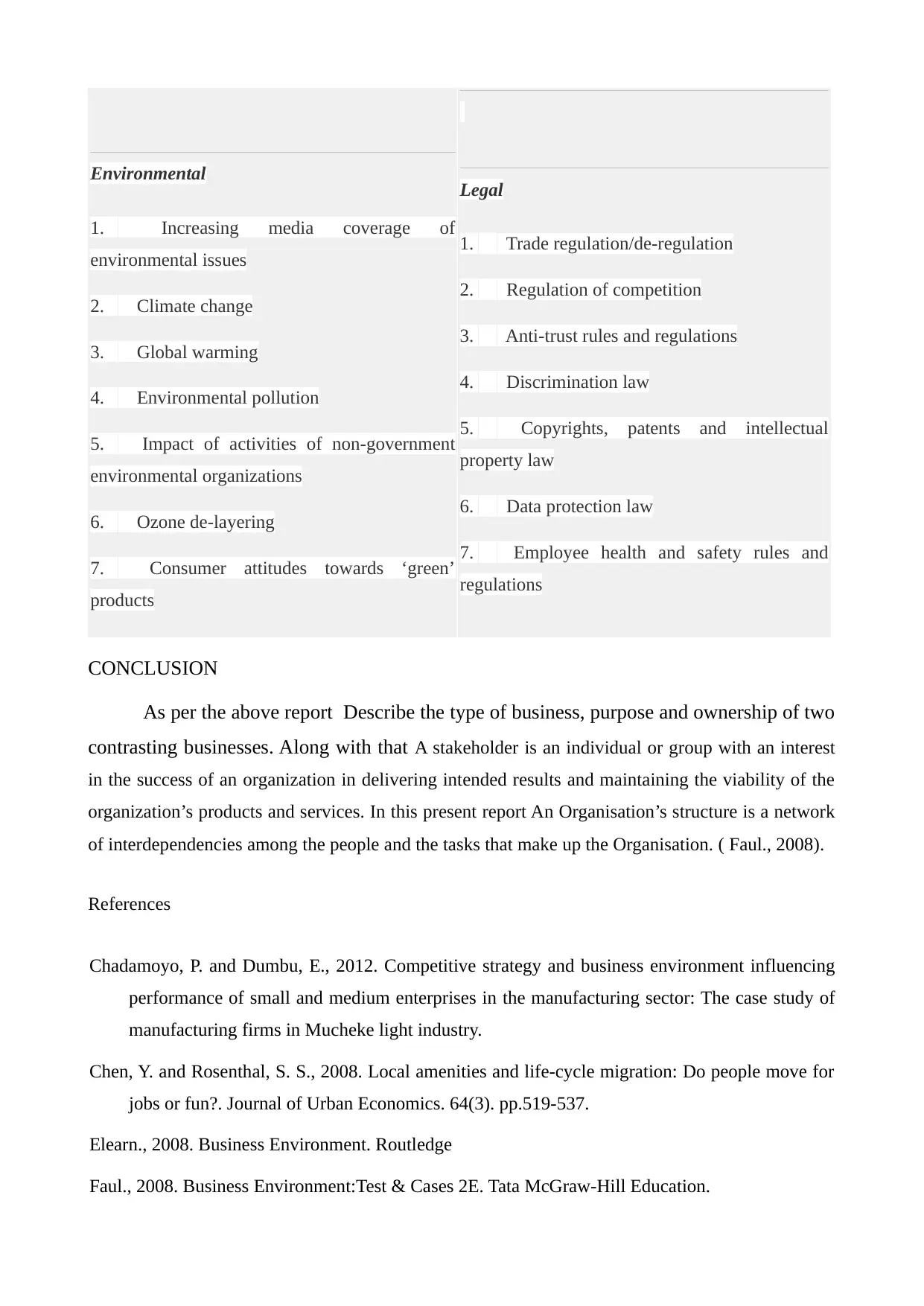
Environmental
1. Increasing media coverage of
environmental issues
2. Climate change
3. Global warming
4. Environmental pollution
5. Impact of activities of non-government
environmental organizations
6. Ozone de-layering
7. Consumer attitudes towards ‘green’
products
Legal
1. Trade regulation/de-regulation
2. Regulation of competition
3. Anti-trust rules and regulations
4. Discrimination law
5. Copyrights, patents and intellectual
property law
6. Data protection law
7. Employee health and safety rules and
regulations
CONCLUSION
As per the above report Describe the type of business, purpose and ownership of two
contrasting businesses. Along with that A stakeholder is an individual or group with an interest
in the success of an organization in delivering intended results and maintaining the viability of the
organization’s products and services. In this present report An Organisation’s structure is a network
of interdependencies among the people and the tasks that make up the Organisation. ( Faul., 2008).
References
Chadamoyo, P. and Dumbu, E., 2012. Competitive strategy and business environment influencing
performance of small and medium enterprises in the manufacturing sector: The case study of
manufacturing firms in Mucheke light industry.
Chen, Y. and Rosenthal, S. S., 2008. Local amenities and life-cycle migration: Do people move for
jobs or fun?. Journal of Urban Economics. 64(3). pp.519-537.
Elearn., 2008. Business Environment. Routledge
Faul., 2008. Business Environment:Test & Cases 2E. Tata McGraw-Hill Education.
1. Increasing media coverage of
environmental issues
2. Climate change
3. Global warming
4. Environmental pollution
5. Impact of activities of non-government
environmental organizations
6. Ozone de-layering
7. Consumer attitudes towards ‘green’
products
Legal
1. Trade regulation/de-regulation
2. Regulation of competition
3. Anti-trust rules and regulations
4. Discrimination law
5. Copyrights, patents and intellectual
property law
6. Data protection law
7. Employee health and safety rules and
regulations
CONCLUSION
As per the above report Describe the type of business, purpose and ownership of two
contrasting businesses. Along with that A stakeholder is an individual or group with an interest
in the success of an organization in delivering intended results and maintaining the viability of the
organization’s products and services. In this present report An Organisation’s structure is a network
of interdependencies among the people and the tasks that make up the Organisation. ( Faul., 2008).
References
Chadamoyo, P. and Dumbu, E., 2012. Competitive strategy and business environment influencing
performance of small and medium enterprises in the manufacturing sector: The case study of
manufacturing firms in Mucheke light industry.
Chen, Y. and Rosenthal, S. S., 2008. Local amenities and life-cycle migration: Do people move for
jobs or fun?. Journal of Urban Economics. 64(3). pp.519-537.
Elearn., 2008. Business Environment. Routledge
Faul., 2008. Business Environment:Test & Cases 2E. Tata McGraw-Hill Education.
⊘ This is a preview!⊘
Do you want full access?
Subscribe today to unlock all pages.

Trusted by 1+ million students worldwide
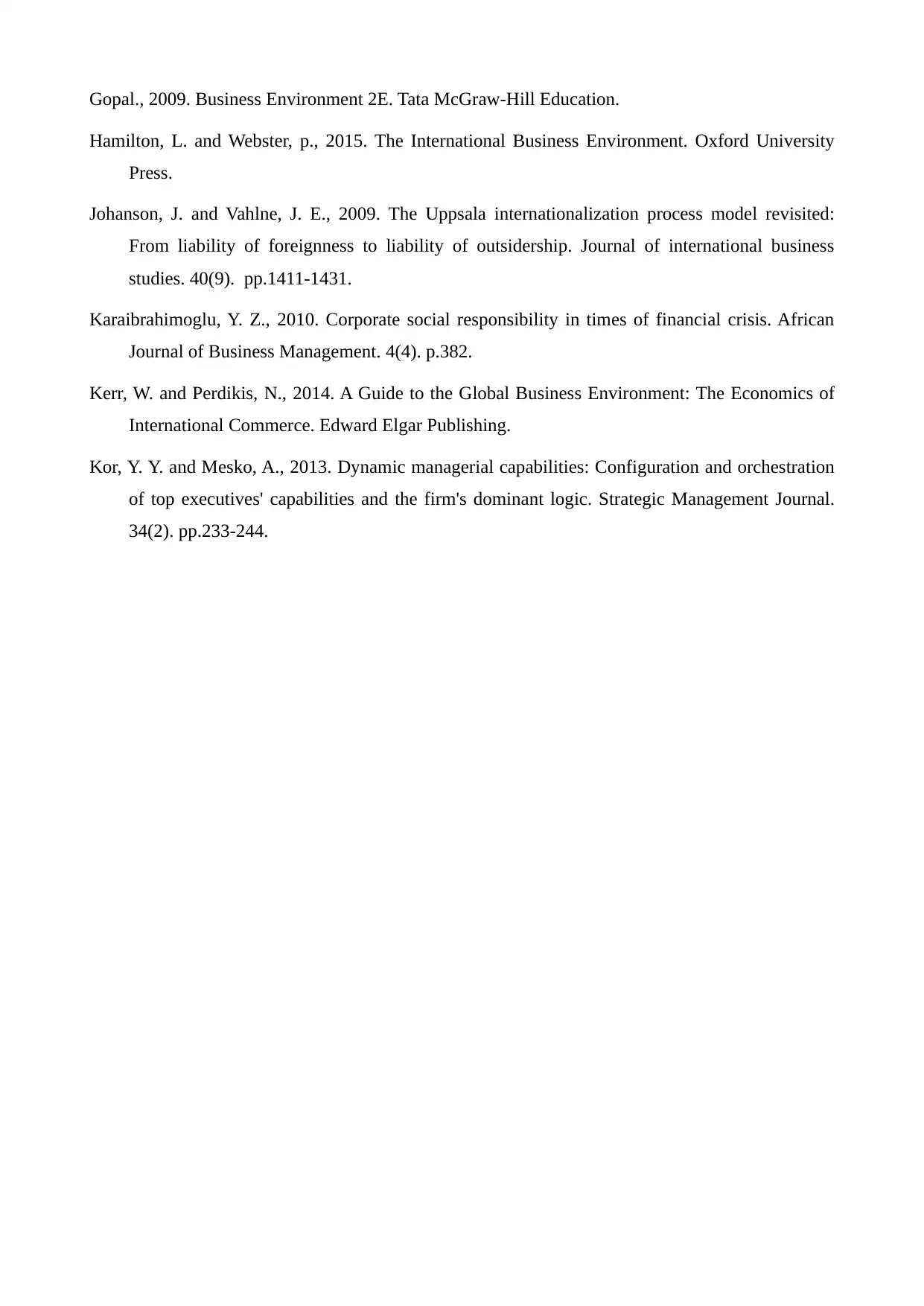
Gopal., 2009. Business Environment 2E. Tata McGraw-Hill Education.
Hamilton, L. and Webster, p., 2015. The International Business Environment. Oxford University
Press.
Johanson, J. and Vahlne, J. E., 2009. The Uppsala internationalization process model revisited:
From liability of foreignness to liability of outsidership. Journal of international business
studies. 40(9). pp.1411-1431.
Karaibrahimoglu, Y. Z., 2010. Corporate social responsibility in times of financial crisis. African
Journal of Business Management. 4(4). p.382.
Kerr, W. and Perdikis, N., 2014. A Guide to the Global Business Environment: The Economics of
International Commerce. Edward Elgar Publishing.
Kor, Y. Y. and Mesko, A., 2013. Dynamic managerial capabilities: Configuration and orchestration
of top executives' capabilities and the firm's dominant logic. Strategic Management Journal.
34(2). pp.233-244.
Hamilton, L. and Webster, p., 2015. The International Business Environment. Oxford University
Press.
Johanson, J. and Vahlne, J. E., 2009. The Uppsala internationalization process model revisited:
From liability of foreignness to liability of outsidership. Journal of international business
studies. 40(9). pp.1411-1431.
Karaibrahimoglu, Y. Z., 2010. Corporate social responsibility in times of financial crisis. African
Journal of Business Management. 4(4). p.382.
Kerr, W. and Perdikis, N., 2014. A Guide to the Global Business Environment: The Economics of
International Commerce. Edward Elgar Publishing.
Kor, Y. Y. and Mesko, A., 2013. Dynamic managerial capabilities: Configuration and orchestration
of top executives' capabilities and the firm's dominant logic. Strategic Management Journal.
34(2). pp.233-244.
1 out of 10
Related Documents
Your All-in-One AI-Powered Toolkit for Academic Success.
+13062052269
info@desklib.com
Available 24*7 on WhatsApp / Email
![[object Object]](/_next/static/media/star-bottom.7253800d.svg)
Unlock your academic potential
Copyright © 2020–2025 A2Z Services. All Rights Reserved. Developed and managed by ZUCOL.





